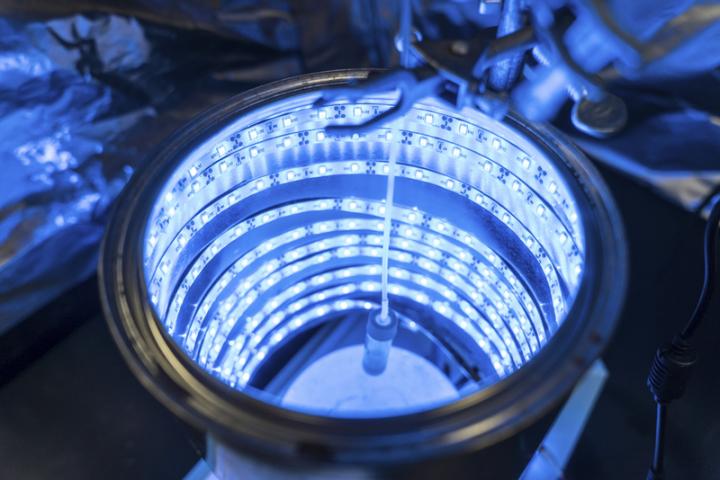Scientists Trigger Artificial Photosynthesis, Cleans Air and Produces Energy
For those who lay awake at night terrified by so-called climate change, please know that a number of innovations have surfaced to head environmental issues off at the pass. What if there were a way to collect and clean the air and produce clean energy at the same time? (On the other hand, what if this type of tampering poses unforeseen problems to the environment?)
Last year, a chemistry professor in Florida found a way to trigger the process of photosynthesis in a synthetic material, turning greenhouse gases into clean air and producing energy all at the same time. Instead of producing plant food, the way photosynthesis does for plants, carbon dioxide could be utilized to clean the air, providing solar fuel at the same time.
The process has great potential for creating a technology that could significantly reduce greenhouse gases linked to climate change, while also creating a clean way to produce energy, University of Central Florida reports.
Widget not in any sidebars
UCF Assistant Professor Fernando Uribe-Romo said:
This work is a breakthrough. Tailoring materials that will absorb a specific color of light is very difficult from the scientific point of view, but from the societal point of view we are contributing to the development of a technology that can help reduce greenhouse gases.
The findings of his research were published in the Journal of Materials Chemistry A.
University of Central Florida reports:
Uribe-Romo and his team of students created a way to trigger a chemical reaction in a synthetic material called metal-organic frameworks (MOF) that breaks down carbon dioxide into harmless organic materials. Think of it as an artificial photosynthesis process similar to the way plants convert carbon dioxide (CO2) and sunlight into food. But instead of producing food, Uribe-Romo’s method produces solar fuel.
It’s something scientists around the world have been pursuing for years, but the challenge is finding a way for visible light to trigger the chemical transformation. Ultraviolet rays have enough energy to allow the reaction in common materials such as titanium dioxide, but UVs make up only about 4 percent of the light Earth receives from the sun. The visible range — the violet to red wavelengths — represent the majority of the sun’s rays, but there are few materials that pick up these light colors to create the chemical reaction that transforms CO2 into fuel.
Researchers have tried it with a variety of materials, but the ones that can absorb visible light tend to be rare and expensive materials such as platinum, rhenium and iridium that make the process cost-prohibitive.
Uribe-Romo used titanium, a common nontoxic metal, and added organic molecules that act as light-harvesting antennae to see if that configuration would work. The light harvesting antenna molecules, called N-alkyl-2-aminoterephthalates, can be designed to absorb specific colors of light when incorporated in the MOF. In this case he synchronized it for the color blue.
His team assembled a blue LED photoreactor to test out the hypothesis. Measured amounts of carbon dioxide were slowly fed into the photoreactor — a glowing blue cylinder that looks like a tanning bed — to see if the reaction would occur. The glowing blue light came from strips of LED lights inside the chamber of the cylinder and mimic the sun’s blue wavelength.
It worked and the chemical reaction transformed the CO2 into two reduced forms of carbon, formate and formamides (two kinds of solar fuel) and in the process cleaning the air.
Uribe-Romo said:
The goal is to continue to fine-tune the approach so we can create greater amounts of reduced carbon so it is more efficient.
What would this look like in practical application?
The idea would be to set up stations that capture large amounts of CO2, like next to a power plant. The gas would be sucked into the station, go through the process and recycle the greenhouse gases while producing energy that would be put back into the power plant.
He is checking to see if other wavelengths of visible light may also trigger this reaction with adjustments to the synthetic material as needed. If so, then this would be additional help in reducing pollution.
There’s even an idea that homeowners could eventually purchase roof shingles with the materials which could clean neighborhood air since air pollution is a rising danger. Likewise, the shingles may produce energy for the homes.
“That would take new technology and infrastructure to happen,” Uribe-Romo said. “But it may be possible.”
Will this invention be enough to quell greenhouse gas fears? If nothing else, it’s certainly an interesting innovation in the world of free energy production.
Sound off below!
This article (Scientists Trigger Artificial Photosynthesis, Cleans Air and Produces Energy) appeared first at Natural Blaze. It can be reshared with attribution but MUST include link to homepage, bio, intact links and this message. IMAGE: YouTube Screenshot
Get a nifty FREE eBook – Like at Facebook, Twitter and Instagram.





